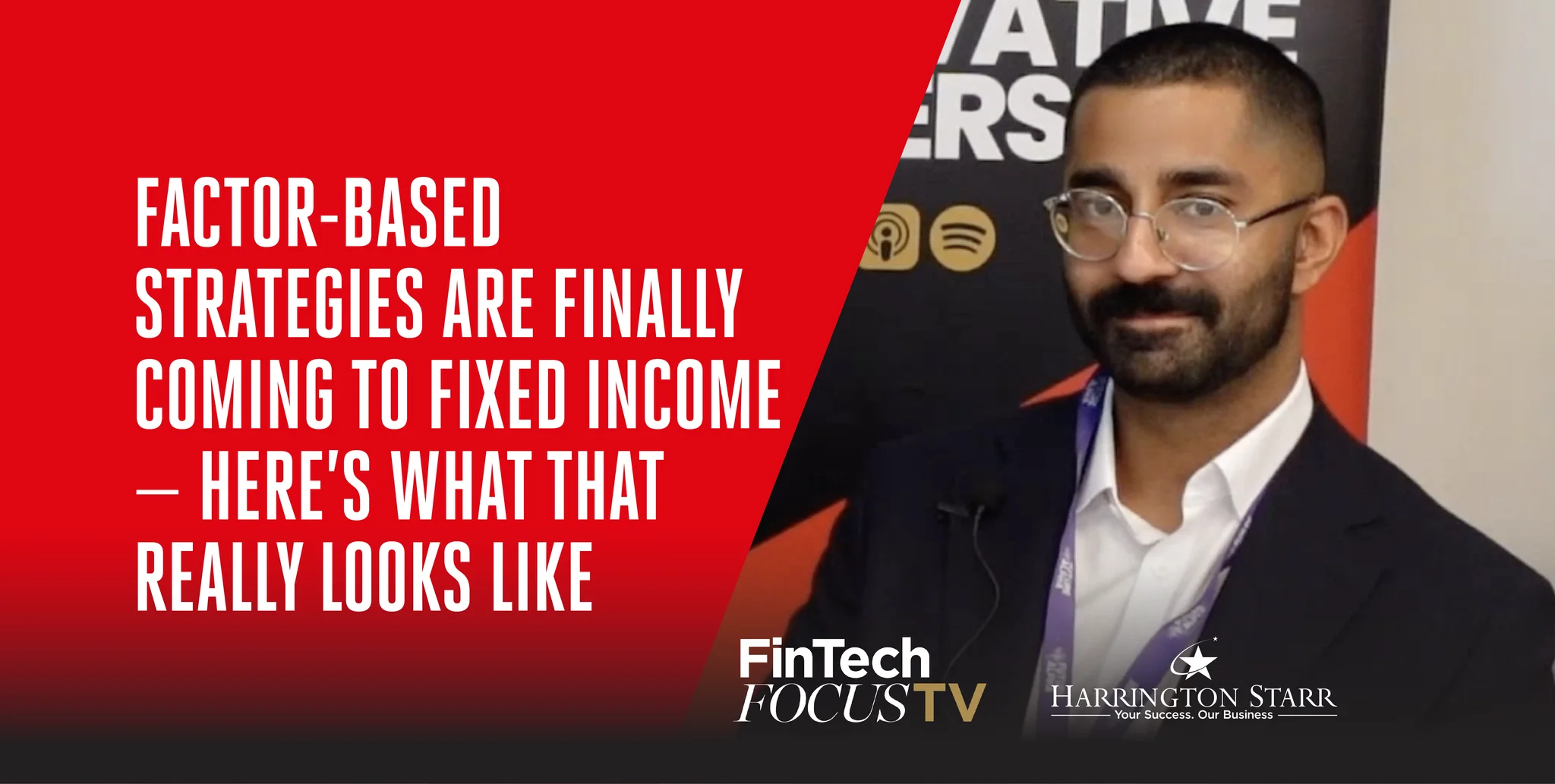Deutsche Börse’s Eurex Dynamics
Recorded live at Quant Strats 2025 in London, this episode of FinTech Focus TV sees Lucia sit down with Anya van den Berg, Global Head of Sales – Analytics at Deutsche Börse, for a detailed exploration into the evolution of analytics, market data accessibility, and the upcoming launch of Eurex Dynamics. As a FinTech recruitment business working at the centre of the industry’s talent landscape, Harrington Starr recognises how conversations like these signal where the market is heading, how data is shifting, and how talent demands will evolve around these changes.
Throughout the discussion, Anya outlines the scale of Deutsche Börse’s data ecosystem, the growth of its analytics products since 2018, the increasing granularity demanded by modern trading firms, and the strategic value of making data more accessible through an entirely new marketplace model.
FinTech Market Data and Analytics: The Core of Anya’s Role at Deutsche Börse
The episode begins with Lucia welcoming viewers to FinTech Focus TV from the bustling surroundings of Quant Strats London, where she introduces Anya as the Global Head of Sales – Analytics at Deutsche Börse. When asked to describe her day-to-day role, Anya explains that she leads the global analytics sales business within the Market Data and Services division, known internally as MD+S. This division serves as the market data layer across Deutsche Börse’s full portfolio of exchanges and services.
The transcript lists the various groups and venues included within the Deutsche Börse ecosystem. Eurex, described by Anya as the leading European derivatives exchange, forms one of the central components. Xetra, the cash equities and ETP venue, further expands the data footprint. The group also includes 360T, the FX venue, and Clearstream, which manages post-trade settlement data and clearing, particularly within the Eurobond space. Anya notes that the group comprises around twenty different divisions in total.
Within this broad ecosystem, the analytics team works with a dedicated group of quants who aggregate data from across the group’s venues and transform it into unique ingestible datasets used by buy-side and sell-side customers. The purpose of these datasets is to provide insight that helps optimise trading strategies, reveal market sentiment, and bring a level of transparency that cannot be found elsewhere.
This foundation sets the stage for the conversation: understanding how Eurex Dynamics builds on an already robust data infrastructure and why its launch marks a significant milestone for Deutsche Börse’s analytics offering.
FinTech Product Evolution: How Eurex Insights Grew into Eurex Dynamics
When Lucia asks about the difference between the earlier analytics offering and the new Eurex Dynamics, Anya goes into detail about the product’s origins. Eurex Flows, which later became part of the Eurex Insights suite, originally launched in 2018 alongside the formation of the analytics sales team. At that time, the coverage was small, only fifty of the most active futures and options were included.
From this modest starting point, the product has gone through years of expansion and refinement. By the time of this interview, the suite had progressed to version 5.1. The upcoming launch of Eurex Dynamics represents its next stage, with significant upgrades in coverage, granularity, and data structure.
The most notable shift is the expansion from fifty products to more than 1,500 Eurex products, with only FX and single stock futures excluded. This means that virtually the entire Eurex futures and options market will now be covered. The granularity of the dataset also increases dramatically. Eurex Insights has historically provided distinctions between agent, market maker, and proprietary trader activity, categories defined through the T7 exchange protocol, where participants must flag their trading role. This accuracy is a key strength of the dataset.
Eurex Dynamics builds on this foundation by adding around one hundred proprietary metrics. These new metrics introduce distinctions between passive, aggressive, and off-book activity. Within off-book activity, the dataset captures EFS, EFP, TES, and block trades. The addition of buy, sell, and sum directional data allows users to track who is buying or selling within specific participant groups and on which futures or options. Anya notes that this granularity and expanded coverage have been very well received by customers across market-making, hedge fund, and proprietary trading communities.
Quantitative Finance Recruitment Trends: Who Gains the Most from Eurex Dynamics?
Lucia then asks which types of users, teams, and firms benefit most from this enhanced dataset. Anya’s response reinforces how widespread the use cases are.
She explains that when the original product was built in 2018, it was actually created at the request of a tier-one bank. The initial assumption was that this would remain a niche use case, but adoption has since expanded far beyond that. One of the dataset's greatest strengths is the depth of its history, which stretches back to January 2003. This deep history allows quantitative firms on the buy-side to conduct detailed backtesting and extract meaningful signals from long-term patterns. According to Anya, there is an exceptionally high conversion rate, around 99%, when buy-side firms evaluate the data, because the quality and clarity of the signal is so strong.
On the sell-side, many tier-one banks incorporate the data into their research reports distributed to buy-side clients. This creates a natural cycle of visibility, where the buy-side sees the data referenced in research and then seeks access to it directly. Banks also consume the data just before market open so that they can enter investor conversations equipped with information unavailable anywhere else. The uniqueness of the data, made possible by the mandatory self-declaration of participant types on the exchange, enhances the credibility of these interactions.
Market makers, particularly those operating in low-latency environments, look at the data from an HFT perspective. The distinctions between aggressive, passive, and off-book trades play a valuable role in modelling strategies that rely on micro-level behavioural insights.
FinTech Digital Transformation: The Launch of the Deutsche Börse Marketplace
The conversation then shifts to the new Deutsche Börse marketplace, which launched at the end of August. Lucia asks why the marketplace is such a significant development.
According to Anya, the marketplace replaces the older Deutsche Börse data shop, which had been in place for many years. Under the previous system, making even simple changes, such as adding a user or adjusting a subscription, required submitting a support ticket and waiting for it to be handled manually.
The marketplace removes this friction. Customers can now add users instantly, modify subscriptions themselves, and fast-track trials with just a few clicks. This shift places control directly in the hands of customers rather than the support teams. The marketplace also speeds up the process of agreeing to terms and receiving permission to access data. Anya notes that trial access can often be granted within a few hours, significantly accelerating the adoption process.
Beyond efficiency, the marketplace represents a more accessible way for customers to explore data. With over one hundred datasets available across ten internal data sources—including twenty-seven dedicated to Eurex, customers can review sample files, read data dictionaries, and view detailed presentations directly within the marketplace interface. This makes evaluation easier and reduces barriers for firms looking to understand what the data can offer.
FinTech Data Strategy: The Hyperion Project and Data Mesh Vision
Lucia then frames the marketplace as potentially part of a larger strategy, asking whether it forms part of a broader plan to make data easier to access across the organisation. Anya confirms that it does. The marketplace aligns with the internal Hyperion project, which focuses on building a data mesh to bring all divisions across the Deutsche Börse group into a unified system. Over time, the intention is for all data sets across the group to be integrated into the marketplace, making it a central access point for the organisation’s entire data offering.
Although the transcript only touches briefly on Hyperion, it signals an industry-wide trend: consolidating complex data structures into more user-friendly access layers. This shift mirrors developments across the FinTech and market infrastructure landscape, where firms increasingly rely on unified data frameworks to support both internal analytics and external customers.
FinTech Product Adoption: Market Response to Eurex Dynamics
When discussing what has been most exciting about bringing Eurex Dynamics to market, Anya highlights the unusually strong customer response. She explains that traditionally, launching a new product requires significant PR efforts, press releases, social media campaigns, and extended periods of attracting interest before testing begins.
Eurex Dynamics has followed a different trajectory. Because the enhancements were based directly on customer feedback, and because existing customers were eager to explore the improvements, the product gained traction even before its official release. Anya describes how multiple clients signed up to the upgraded service after reviewing the sample files, despite the product not yet being fully launched. This early enthusiasm demonstrates the demand for expanded coverage, reduced censoring, and increased granularity.
FinTech Data Access: How Firms Can Explore Eurex Dynamics
As the discussion draws to a close, Lucia asks how listeners can learn more or trial the new product. Anya explains that all relevant information can be found within the Deutsche Börse marketplace. Users simply need to select Eurex as the data source, where they will find twenty-seven different datasets related to Eurex alone, and over one hundred datasets across the wider group.
Each product page contains sample files, a data dictionary, and a detailed presentation. Customers can initiate a trial through a fast-track process which, after completing standard KYC checks, provides access to several years of historical data within hours.
FinTech Recruitment Perspective: Why Conversations Like This Matter
For Harrington Starr, discussions like this reflect the innovation shaping the FinTech and quantitative finance landscape. As market data becomes more granular, accessible, and indispensable to trading strategies, the demand for talent capable of working with these datasets rises sharply. Firms now require quants, data engineers, analytics specialists, and trading technologists who can understand, interpret, and operationalise complex datasets like those found within Eurex Dynamics.
The evolution described by Anya, moving from 50 products to more than 1,500, adding detailed metrics, building a flexible marketplace, and creating a unified data mesh, mirrors the transformation underway across financial technology. As FinTech recruitment specialists, Harrington Starr continues to support companies seeking the skills needed to thrive in this environment, helping them build teams capable of navigating the increasing sophistication of market data and analytics.
As a FinTech recruitment partner working across Quantitative Finance, Data, Product Management, Cloud Engineering and DevOps, Cyber Security and IT Risk, Infrastructure Support, Network Engineering, Sales and Marketing, and Software Engineering roles, Harrington Starr knows how critical market-defining technologies are to the talent landscape. This episode offers a rare insider look at how one of the world’s most influential exchange groups is evolving its analytics suite and what that means for the future of trading, strategy design, and data-driven decision-making.






